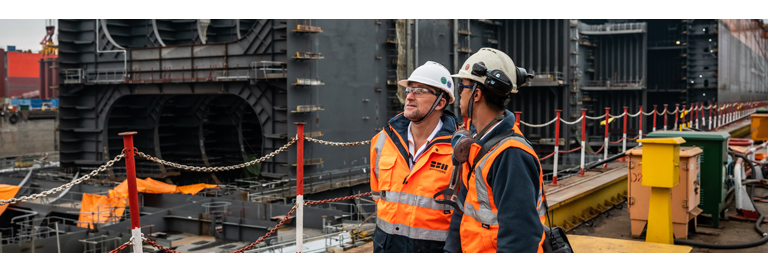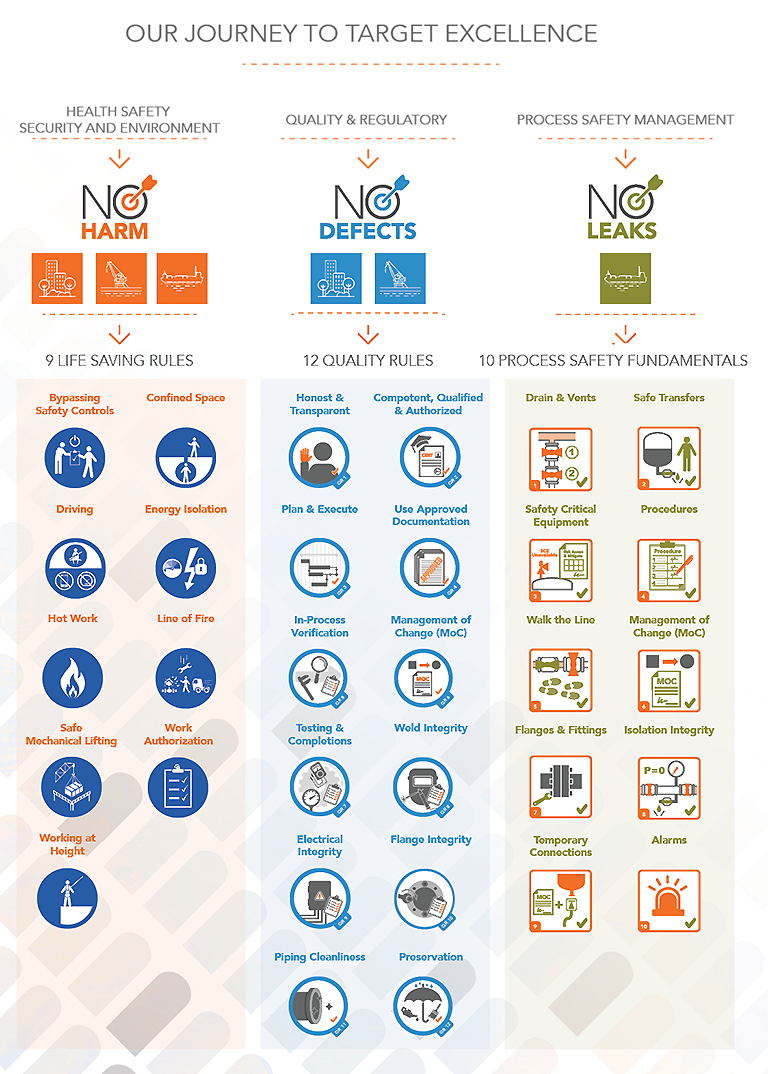2.6Health, Safety, Security and Environment
Management Approach
SBM Offshore is committed to safeguarding the Health, Safety and Security (HSS) of its employees, subcontractors and assets, as well as to minimizing the impact of the Company's activities on local ecosystems and proactively protecting the environment. SBM Offshore applies controls and safeguards based on a lifecycle hazard management process and an integrated management system, underpinned by the Company's Health, Safety, Security & Environment (HSSE) culture development program. In line with the Company's HSSE Policy statement, SBM Offshore defines its HSSE requirements in compliance with applicable legal requirements and ISO standards, as well as international oil and gas practices (International Association of Oil and Gas Producers – IOGP).
SBM Offshore:
- follows the guidance of ISO17776 for hazard management, identifies work-related hazards and assesses risks for routine and non-routine activities in a systematic manner through a range of different methodologies commensurate with the type of activity being assessed and adopts a progressive approach to risk reduction until no further risk-reducing measures are reasonable.
- investigates all incidents with an actual or a potential consequence for the Health, Safety and Security of personnel and/or impact on the Environment arising out of the Company's activities and records the information in a centralized incident management tool. The outcome of the investigation, the immediate and root causes identified and the agreed actions to prevent re-occurence includes wider Company improvement and communication where relevant.
- continues the journey to Target Excellence, with the objectives of No Harm, No Defects, No Leaks. For the No Harm goal, SBM Offshore sets the expectations for all employees and the companies to whom SBM Offshore outsources, to intervene on unsafe acts, unsafe situations and non-compliance with Life Saving Rules, to stop the work if they feel anything is unsafe and to report on interventions and any incidents. The LIFE365 program, as an integral part of the Target Excellence journey, frames the development of the HSSE leadership and culture development in the Company. For more information on Target Excellence, please refer to section 2.7.
- values pro-active consultation and open communication with employees through structured dialogue and joint committees, encourages participation in HSSE-related initiatives, campaigns and Life Day.
- implements a health control framework, which includes a fitness to work process, regular medical check-up and specific health surveillance, as well as medical emergency arrangements.
- provides HSSE training based on the role and the type of work to be performed, which covers the full range of Company activities. Training programs raise employees' awareness and bring them the skills to intervene on unsafe acts and situations, as well as to behave as inspiring safety leaders promoting and sharing Company's values and proactive culture (see section 5.2.1).

2019 Performance
SBM Offshore assesses Company HSSE performance through a set of indicators, with a specific focus on the core following indicators:
- Number of work-related injuries and ill health, including number of security related incidents
- Volume of emissions into the air: flaring and related emissions
- Amount of energy consumed
- Volume of discharges into the sea
HSSE data are tracked daily, consolidated monthly, and disclosed on an annual basis. Results are recorded and reported in accordance with the Global Reporting Initiative (GRI) Standards and IOGP guidelines. The results are compared to previous years, as well as benchmarked against the IOGP averages.
Key targets
To pursue Company HSSE performance improvement, SBM Offshore set the following targets for 2019:
- To achieve a Total Recordable Injury Frequency Rate (TRIFR) target of 0.29 without any fatality.
- To reduce the quantity of gas flared under SBM Offshore control by 20% compared to 2018.
- To reduce the plastic wastes generated onboard offshore units by 40% compared to 2018.
- To achieve a better environmental performance than the 2017 IOGP industry average benchmark1 for the following environmental aspects: greenhouse gas (GHG) emissions2, gas flared3, energy consumption4, oil in produced water5 and oil spills per production.6
Key achievements
The Company continued to expand the HSSE initiatives in 2019 as follows:
- Maintained all International Safety Management (ISM) and International Ship and Port Facility Security (ISPS) certifications on offshore units and shorebases, as well as verification of compliance with ISO 14001 and OHSAS 18001 requirements for SBM Offshore Operations. This includes obtaining the ISO 14001 and OHSAS 18001 compliance verification on the most recent unit, FPSO Liza Destiny and corresponding shorebase.
- Engaged at project management level and at offshore unit level to strengthen the ownership of a safety culture among leaders and supervisors.
- Deployed the nine Life Saving Rules published in October 2018 by the IOGP, adopting the recently updated industry practices.
- Performed culture survey and further improvements of the key controls and lessons learned from incident investigations.
- Strengthened the controls in view of the changing security threats impacting on the business activities.
- Deployed the Company-wide Life Day and engagements with employees via multi-disciplinary monthly campaigns.
- Pursued efforts and actions supporting the objective to reduce the volume of gas flared under the control of the offshore units and to reduce the amount of plastic waste generated on offshore units.
The following graph shows that SBM Offshore’s Total Recordable Injury Frequency Rate has remained around the IOGP average since 20127.

Key results
Despite continued year-on-year improvement in the ability to prevent injuries during 2019, regrettably one contracted diver was fatally injured during installation activities of a pipeline section replacement project offshore Angola in December. The investigation has identified root causes for which a set of actions have been implemented and further preventive measures have been initiated. SBM Offshore achieved the following HSS performance in 2019:
- SBM Offshore performed better than its TRIFR target of 0.29 and achieved an overall TRIFR of 0.13 in 2019 better than 0.18 in 2018.
- The Occupational Illness Frequency Rate (OIFR) for employees improved to 0.01 in 2019 from 0.33 in 2018, recovering to a level to that of 2017 (0.02), with one occupational illness occurence.
- The frequency rate of incidents with high-consequence work-related injury remained at 0 in 2019, equal to the 2018 rate.
- 15 ’work-related’ security incidents (as opposed to safety incidents) were reported. None of these security incidents resulted in any actual injury or physical harm to SBM Offshore personnel.
The following environmental performance was recorded in 20198:
- GHG emissions from energy generation and gas flared relative to the hydrocarbon production remained stable compared to 2018. A total of 5,668,961 tonnes of GHG were emitted in 2019, representing 105.54 tonnes of GHG emissions per thousand tonnes of hydrocarbon produced, almost equivalent to the 2018 result and 30% lower than the industry benchmark9. This result is mainly due to a similar amount of volume of gas flared compared to 2018 (see next bullet point).
- The total gas flared in 2019 remained equivalent to the 2018 level with 11.87 tonnes per thousand tonnes of hydrocarbon produced (of which 67% was requested by the client) compared to 11.45 in 2018 (see Data revisions section5.2.2). The amount of gas flared under SBM Offshore control was 3.95 tonnes per thousand tonnes of hydrocarbon produced compared to 3.98 in 2018, which represents a reduction of 0.7%, therefore it did not meet the initial set target of 20% reduction. A plan to address the flaring challenges is in place on the 2019 significant contributors and status monitored regularly. The Company reports a total gas flared per production just below the IOGP industry benchmark10 of 12.1.
- The amount of plastic waste generated onboard reduced by approximately 22% from 215,724 tonnes in 2018 to 168,482 tonnes in 2019 thanks to a number of actions implemented onboard offshore units. Whilst the ambitious stretched target of 40% reduction was not achieved, the initiative created momentum in the organization and highlighted specific difficulties in some regions.
- The volume of energy consumption used per hydrocarbon produced remained stable at 1.15 gigajoules of energy for every tonne of hydrocarbon produced compared to 2018 (see re-statement), which is 23% lower than the industry benchmark.11
- The quantity of oil discharged to sea per hydrocarbon production was 5.13 tonnes per million tonnes of hydrocarbon produced, compared to 5.33 in 2018 (see re-statement), while the IOGP average is 13.3. The Company continues to perform here much better than the industry.
- There was no hydrocarbon spill exceeding one barrel in volume (159L), while the industry benchmark12 is 0.5.
future
SBM Offshore has defined its 2020 ambition with the following targets:
- To achieve a TRIFR better than 0.20.
- To reduce the overall quantity of gas flared under SBM Offshore control by 25% compared to 2019.
- All offshore units to achieve better environmental performance than the 2018 IOGP industry benchmark13 for the following environmental aspects: GHG emissions14, gas flared15, energy consumption16, oil in produced water17 and oil spills per production.18
- To reduce by 10% the plastic wastes generated onboard offshore units.
SBM Offshore has set up the following key initiatives for 2020 to achieve the Company's ambition on the sustainability goals and support continuous improvement:
- Promote safe working environments, assure performance through building internal, and leveraging external, capacity.
- Standardize safe working practices and improve assurance on their implementation.
- Develop and embed leadership behavioral practices, continue the offshore leadership skills program deployment and project management team engagement, initiate the development of safety leadership in action program for project supervisor’s and assess synergy opportunities with companies to which SBM Offshore outsources.
- Strengthen security resources worldwide and maintain security controls on activities and preparation of new country entry.
- Promote health and wellbeing through structured framework arising out of risk assessments and supported by robust reporting.
- Increase health and welfare awareness and health related controls on specific topics.
- Maintain compliance with all existing certification requirements on shorebases and offshore units.
